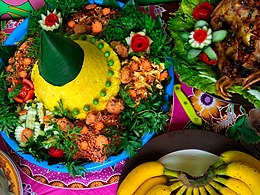 Jajan pasar (market snacks) in Java, consisting of assorted kue | |
| Alternative names | Kueh (Hokkian), Kuih (Brunei, Malaysia, Singapore) |
|---|---|
| Course | Snack |
| Place of origin | Indonesia |
| Region or state | Nationwide |
| Main ingredients | Various traditional snacks |
| Similar dishes | Kuih, Mont, Khanom, Bánh |
 |
| This article is part of the series on |
| Indonesian cuisine Masakan Indonesia |
|---|
|
|
Kue are bite-sized snacks or desserts originally from what is now Indonesia but have since spread throughout Southeast Asia. Kue is a fairly broad term in Indonesian to describe a wide variety of snacks including cakes, cookies, fritters, pies, scones, and patisserie.[1] Kue are made from a variety of ingredients in various forms; some are steamed, fried or baked.[2] They are popular snacks in Indonesia, which has the largest variety of kue. Because of the countries' historical colonial ties, Koeé (kue) is also popular in the Netherlands.[3]
Indonesian kue demonstrate local native delicacies, Chinese and Indian influences, as well as European cake and pastry influences. For example, wajik, kue bugis, klepon, nagasari, getuk, and lupis are of native origin; while bakpia and kue ku are of Chinese Peranakan origin, kue putu is derived from Indian puttu; on the other hand, lapis legit, kue cubit, kastengel, risoles and pastel are European influenced.
- ^ "Kue". Kamus.net. Retrieved 22 October 2012.
- ^ "Hasil Pencarian - KBBI Daring". kbbi.kemdikbud.go.id. Retrieved 2018-07-02.
- ^ Indonesisch Kookboek Selamat Makan (PDF). Koninklijke Marine. 1999.
